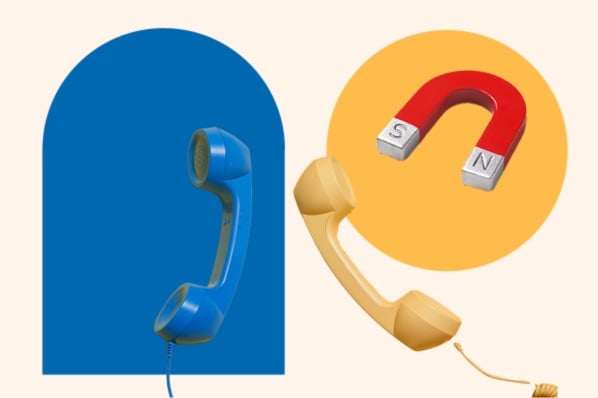Once a week, I attend film review, where a HubSpot salesperson presents a recorded call for coaching. The meeting features a new rep and new prospect every time, but the same question comes up again and again: “Why did this prospect take the call?”
If the rep can’t answer this question, it’s usually because they’ve failed to identify their buyer’s most pressing need. And that indicates they may lose the deal. Without knowing what’s driving their prospect, the salesperson can’t effectively explain their product’s value.
There are five main ways a product can improve the buyer’s life: It can save them money, make them money, save them time or effort, reduce risk, or address one of their human desires. Although a product might achieve some or even all of those things, salespeople should focus on the value that’s most directly related to their prospect’s biggest priority.
Once the buyer sees a clear link between their greatest need or desire and the rep’s offering, they’ll be highly motivated to buy it -- and quickly. In addition, this value-based approach puts the salesperson in a strong position for the negotiation stage.
To capitalize on this effect, salespeople must pay careful attention to their prospects’ priorities and craft their messaging and questions accordingly.
How to Identify Your Buyer's Most Pressing Need [Cheatsheet]
1) The Prospect Wants to Make Money
How to identify this need: A prospect whose biggest priority is making money will typically bring up their sales and revenue targets, expansion plans, and/or need for growth. They’re focused on hitting the gas pedal, not improving the car’s steering functionality or fixing the windshield.
How to sell to this prospect: The most effective way to reach these prospects is to show them clear ROI. Leverage case studies, cite real research, and even offer to build them a customized business case so they understand what they’re getting for every dollar they spend.
Try to avoid vague statements like, “This will improve your profits,” or “Your revenue is guaranteed go up.” These prospects will only be convinced by concrete examples and numbers.
Example:
- “It currently takes approximately 15 minutes to complete the checkout process in your store. According to our research, roughly half of consumers will decide not to buy anything if they have to wait longer than eight minutes. Our consultants will redesign your checkout flow so it’s one-third as long. Clients of your size and vertical usually see sales increase by 300% in one quarter.”
2) The Prospect Wants to Save Money
How to identify this need: If the buyer’s most pressing priority is saving money, they’ll typically use phrases like “cutting back,” “trimming the fat,” “getting leaner,” or “tightening their belt.” They may also express anxiety about going over their budget for the quarter or a project related to the product.
These buyers might also say they need to “reduce inefficiencies” or “eliminate redundancies,” which can sound like a time or effort-related concern (see #3) but is chiefly about eliminating unnecessary spend if they don’t mention these inefficiencies making their jobs harder.
How to sell to this prospect: Due to the nature of their concerns, these prospects are inherently price-conscious. To close them, salespeople must demonstrate why they need to spend money to save it.
It’s usually helpful for sellers to quantify exactly how much buyers will save and when they’ll start getting those dollars back. Some companies create ROI calculators that prospects can use to see their potential savings (check out HubSpot’s ROI calculator here). Reps who don’t have this resource can create a simple ROI calculator in Excel.
To fully convince their prospects, they should also point to case studies, testimonials, or the product’s historical ROI.
Reps should find out exactly how price-sensitive these buyers are. While an influential decision maker can usually secure more budget for a project once value is demonstrated, there’s still a limit to how much money they can get if budget is a company-wide concern. Talk about ballpark numbers early on to avoid an unpleasant surprise at the end of the process.
Example:
- “Creating a customer forum where your customers can answer each other’s questions will reduce the number of support reps you need by approximately 5%. At your current size, you’ll be saving $15,000 a month, which allows you to put money toward expansion. As you grow, your savings will increase -- the companies we’ve worked with that are approximately one year older than you are saving $50,000 per month. That doesn’t include the money you’ll save on hiring and recruiting support reps, which is roughly $4,000 per new employee.”
3) The Prospect Wants to Reduce Time or Effort
How to identify this need: First, if the prospect seems overworked, anxious, or stressed, there’s a good chance they’ve got too much on their plate.
Second, if they mention multiple times how time- or labor-intensive it is to accomplish something, they’re probably looking for a solution that’ll reduce that investment.
A buyer who’s filling multiple big roles or wearing several hats -- for example, a director of sales and marketing or a graphic designer who’s also doing visual work -- is also likely looking for a time- and effort-saving solution.
How to sell to this prospect: With these prospects, salespeople would be wise to focus on how the product will simplify their process or eliminate specific tasks. Reps can also explain how their product enables the buyer to delegate or outsource their work.
Examples:
- “You currently log into four separate apps to do X. With our tool, you can do everything from one place.”
- “Our tool makes it easy for even non-designers to make infographics. Rather than creating them yourself, you can ask your direct reports or interns to make them. That’ll save you approximately 10 hours per week or 40 hours per month.”
- “Our sensors use a high-frequency electric field to monitor the permittivity of your soil over time. You’ll never have to manually check soil moisture again.”
4) The Prospect Wants to Reduce Risk
How to identify this need: Minimizing risk is top-of-mind for some prospects. That’s especially true for industries that demand perfection (like the automotive, biotechnology, semiconductor, electrical, medical device, and pharmaceutical industries, to name a few).
But prospects in industries with less need for absolute rigor, like software or media, can still be motivated by the need for security. Salespeople should keep their ears perked for stories about getting burned by poor quality in the past. They should also look out for prospects who want to know a product or deliverable is perfect before it’s released -- even if that means sacrificing speed.
How to sell to this prospect: Reps can appeal to these prospects by highlighting their product’s proven ability to reduce risk with customer testimonials, case studies, and statistics. First, salespeople should identify the problem or potential issue. Then, they should explain in detail how their offering helps customers avoid or mitigate risk.
Terms such as, “safety,” “security,” “full transparency,” “high confidence,” “certainty,” and “risk management” will help them drive their point home.
Example:
- Before: “Our postponement system splits the manufacturing process into two parts. We’ll build the generic components of a product and keep those parts on-hand until you finalize your plans. At that point, we’ll assemble the final product. This approach makes you extremely responsive to market trends. You’ll always have the latest popular item in your stores.”
- After: “You’ve mentioned that you’d like to improve your product sales forecasts. Our clients have improved their accuracy by 30% on average by using our postponement system, which lets you delay your upfront investment in product assembly until you’ve done ample market research. In other words, you can be far more confident in product-market fit without changing your planned launch dates.”
5) The Prospect Wants to Address a Human Need
How to identify this need: Sometimes, buyers have personal motivations for wanting a product. They may be hoping to increase their status inside their organization, feel more secure within their role, or decrease their reliance on their coworkers.
Salespeople must usually read between the lines to pick up on these personal drivers. It’s rare to hear prospects things like, “I want to buy this so my team members see I can add real value.”
More likely, they’ll say something along the lines of, “I’m new in my role, and I think this product could help me show my coworkers the value of doing [new initiative].”
How to sell to this prospect: Once a rep has intuited her prospect’s emotional desire, she should confirm that desire with him. Not only does this step help her avoid making an incorrect assumption, it also gives her an ideal segue into explaining how the product will satisfy her prospect’s need.
Wondering how to actually draw this link? Try explaining how a similar prospect with the same desire profited from the purchase. This strategy helps buyers see how they’ll personally benefit.
Examples:
- If the rep senses the buyer is angling for a promotion, she could say, “It sounds like you’re interested in a more senior position. Would you say that’s accurate?” Once the prospect says yes, the salesperson might respond, “Transforming your organization’s process for X usually increases your internal visibility, which can boost the likelihood of a promotion. I worked with another manager similar to you who experienced [result #1] and [result #2]. Two months later, she was promoted to [position].”
- If, on the other hand, the rep thinks their prospect is worried about a potential termination, she might ask, “I’ve sensed job security is important to you. Would you say that’s a fair judgment?” The prospect says, “Yes, that’s right,” so the salesperson replies, “Implementing a new successful program for X typically solidifies your position. I actually worked with [job title] a year ago in a similar position -- the organization was downsizing pretty heavily and he wasn’t sure if his position would remain. Driving [result #1] and [result #2] with [product] helped him prove his value. He’s still at that job.”
Once you make it crystal clear how your product will help the buyer with their most pressing need or desire, the deal is usually in the bag. Use this guide to figure out what your prospects want -- then give it to them.
Sales Qualification



![How I use BANT to qualify prospects [+ expert tips]](https://53.fs1.hubspotusercontent-na1.net/hubfs/53/bant-questions-6606f7b6c0d9e.webp)



![21 Signs Your Buyer Is a Poor Fit [Sales Process Checklist], According to HubSpot's Former Sales Director](https://53.fs1.hubspotusercontent-na1.net/hubfs/53/Bad%20fit%20checklist.jpg)



